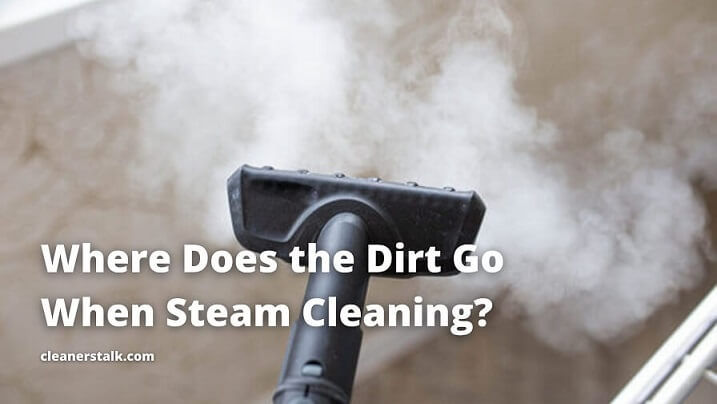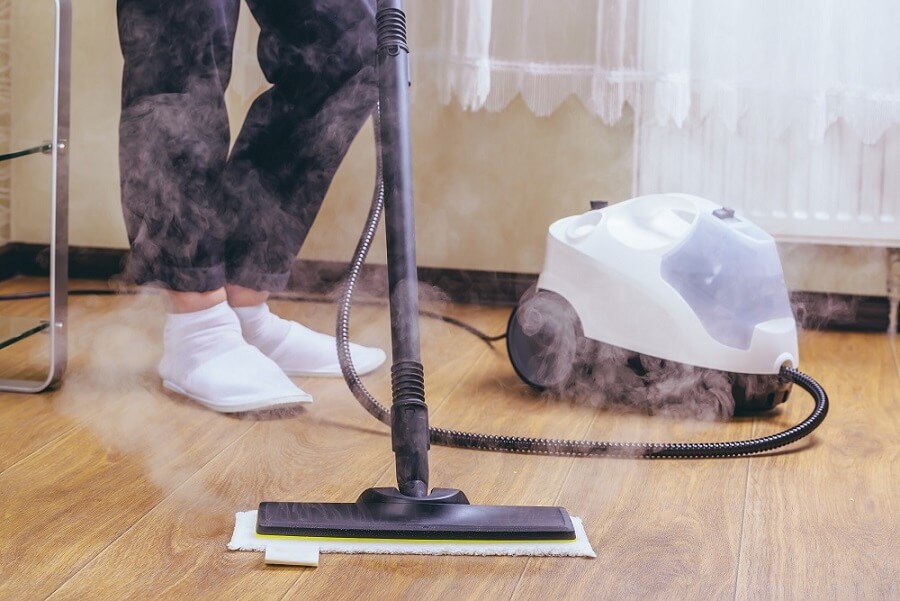
Where Does the Dirt Go When You Steam Clean?
Cleaners Talk is reader-supported. This post contains affiliate links, we may earn a commission at no additional costs to you. As an Amazon Associate we earn from qualifying purchases.
When vacuuming your floors or furniture no longer seems to get them looking clean, it might be time to consider using a vapor steam cleaner. By only using water and no chemicals, they can clean different types of surfaces very well. This method of cleaning has many wondering where the dirt goes after steam cleaning.
Where does the dirt go when you steam clean? When steam cleaning, the dirt does not “go anywhere.” Instead, the dirt is broken down by the heat from the water vapor but remains in the area. To remove the loosened dirt from the area, you need to manually wipe it with a steam mop, cloth or vacuum it.
Furthermore, a steam cleaner’s ability to clean is based primarily on its heat. To best clean an area using a vapor steam cleaner, there are several important considerations you need to understand. In this post, we will talk in greater detail about where the dirt goes when you steam clean. Let’s get started, shall we?
How Does a Steam Cleaner Remove Dirt?
So, how does a steam cleaner remove dirt? Using less than a gallon of tap water, a vapor steam cleaner creates a low-moisture vapor that provides heat to the surface you wish to clean. The heat from the vapor, combined with light agitation, loosens dirt and kills dust mites, mold, staph, allergens, and other harmful bacteria.
The temperature from the vapor is hot enough to kill germs and bacteria, emulsify grease and oil, and clean other surface contaminants. Additionally, because little water is used, it creates virtually no mess. Best of all, most steam cleaners are not only quiet but portable as well. They can be used anytime, anywhere.
Where does the dirt go when you steam clean?

Some steam cleaners come with extra attachments, including mops, to wipe the area after steaming.
After the dirt has been loosened by the heat, it still remains in the area. If you are using a steam cleaner with an attachment (steam cleaner mop) fitted with a microfiber absorption pad, the pad will automatically absorb or capture the loosened dirt. All you have to do is to allow the high-heat moisture to dry.
The dirt does not “go anywhere” when you steam clean. It is, however, loosened by the heat from the vapor or steam.
However, if you are not using an absorption pad, you need to wipe the area manually with a towel or cloth to remove excess moisture and dirt. For heavily soiled surfaces, some manufacturers even suggest steam-cleaning first, then wiping away dirt with a cloth before the moisture dries.
Additionally, you can also vacuum the area after steam cleaning. This is recommended for layered surfaces like carpets. Experts suggest vacuuming your carpets after steam cleaning, but only after the carpet is 100% dry. Doing so will clear any dirt residue that may reside on your carpet, especially if they are thick.
PRO TIP: If you want to have a better understanding of how steam cleaners work, then be sure to read our simple and easy-to-understand guide right here. We wrote the article with beginners in mind to help new steam cleaner users maximize the effectiveness of this amazing and revolutionary cleaning tool.
Frequently Asked Questions About Steam Cleaners
With that said, there are a lot of questions being asked online regarding steam cleaners. It is understandable, though, as steam cleaners offer relatively new technology. To better understand the topic at hand, let’s take a closer look into some of the most frequently asked questions about steam cleaners:
1. Do steam cleaners leave surfaces wet?
Dry vapor steam cleaners do not leave surfaces wet because they produce low-moisture vapor that contains about 5% water, so it dries quickly and leaves almost no damp residue. The high-heat moisture evaporates almost immediately after the steam makes contact with a surface.
However, it depends on the surface you wish to clean. For example, you need about 15 minutes for a carpet to dry completely after steam cleaning. For hard surfaces, like countertops and hard floors, you may need to wipe loosened dirt particles with a microfiber cloth or towel after steam cleaning to clean it completely.
2. Can steam cleaning remove stains?
Many ask the question: can steam cleaning remove stains? Yes, steam cleaning can remove stains. Not only does steam cleaning remove stains, grease, and dirt, but it can also sanitize all surfaces, remove allergens, and kill bacteria, mold, viruses, dust mites, bed bugs, and most pathogens.
In most cases, however, it depends on the type of stain. Some stains may bond with fibers and become irremovable. Take a lipstick stain, for example. It is waxy and will need something more powerful than steam to clean. Certain chemicals may be needed to remove certain types of stains.
Another consideration is the age of the material you wish to clean. For example, if a carpet has thinned enough that the backing is stained, no amount of cleaning will remove it. An old material may not be worth the cost of stain removal. If you are unsure about a stain, it’s best to consult with a professional cleaner.
3. Does a steam cleaner disinfect?

So, does a steam cleaner disinfect? Yes, a steam cleaner can disinfect almost any surface. The heat of the steam can kill about 99 percent of the bacteria and dust mites. In fact, according to the University of Saragossa, the steam is effective enough to disinfect or even sterilize surfaces.
However, there is a catch.
According to Philip M. Tierno, Ph. D, a clinical professor of microbiology and pathology at New York University, most pathogens will die at 212° F. While steam cleaners and mops can get up to that temperature, you will have to hold the mop in place for at least 10 minutes at a time for it to be effective.
Moreover, several steam mop models need to be manually pumped to create steam, which means the temperature may fluctuate. This makes it harder for you to determine whether you are killing any germs or not. After all, a steam cleaner’s ability to clean is based primarily on its heat.
While they may not be the best option for disinfecting, steam cleaners can effectively clean floors and surfaces. Steam cleaners and steam mops have the ability to restore shine, kill fleas, and remove stains. You can have peace of mind knowing that steam cleaners can clean and sterilize an area simultaneously.
Bottom Line
And there you have it, a comprehensive post to answer the question: where does the dirt go when you steam clean? Hopefully, you now know how effective steam cleaners are without the use of chemicals. This results in better indoor air quality and eliminates the need to handle or store cleaning agents.
Related articles:
